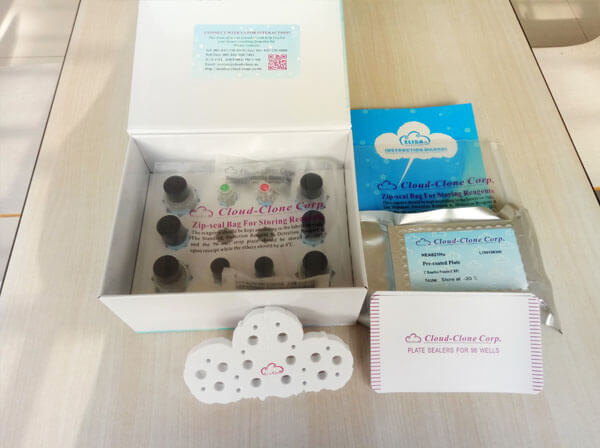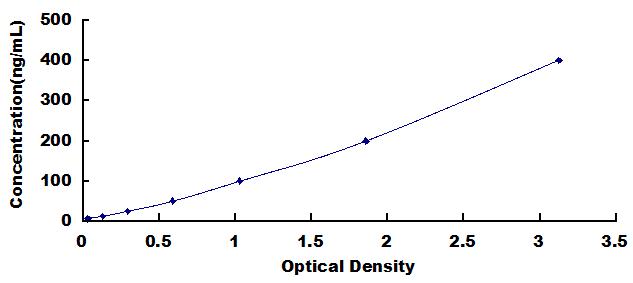Wide-range ELISA Kit for Gelsolin (GSN) 

GS; AGEL; ADF; Brevin; Gelsolin Amyloidosis,Finnish Type; Actin-depolymerizing factor
- UOM
- FOB US$ 372.00 US$ 532.00 US$ 2,394.00 US$ 4,522.00 US$ 37,240.00
- Quantity
Overview
Properties
- Product No.WEA372Hu
- Organism SpeciesHomo sapiens (Human) Same name, Different species.
- ApplicationsEnzyme-linked immunosorbent assay for Antigen Detection.
Research use only - DownloadInstruction Manual
- CategoryTumor immunityInfection immunity
Sign into your account
Share a new citation as an author
Upload your experimental result
Review

Contact us
Please fill in the blank.
Recovery
Matrices listed below were spiked with certain level of recombinant Wide-range Gelsolin (GSN) and the recovery rates were calculated by comparing the measured value to the expected amount of Wide-range Gelsolin (GSN) in samples.
| Matrix | Recovery range (%) | Average(%) |
| serum(n=5) | 94-102 | 98 |
| EDTA plasma(n=5) | 89-96 | 93 |
| heparin plasma(n=5) | 88-102 | 92 |
Precision
Intra-assay Precision (Precision within an assay): 3 samples with low, middle and high level Wide-range Gelsolin (GSN) were tested 20 times on one plate, respectively.
Inter-assay Precision (Precision between assays): 3 samples with low, middle and high level Wide-range Gelsolin (GSN) were tested on 3 different plates, 8 replicates in each plate.
CV(%) = SD/meanX100
Intra-Assay: CV<10%
Inter-Assay: CV<12%
Linearity
The linearity of the kit was assayed by testing samples spiked with appropriate concentration of Wide-range Gelsolin (GSN) and their serial dilutions. The results were demonstrated by the percentage of calculated concentration to the expected.
| Sample | 1:2 | 1:4 | 1:8 | 1:16 |
| serum(n=5) | 80-93% | 94-103% | 93-104% | 81-98% |
| EDTA plasma(n=5) | 89-96% | 81-96% | 81-104% | 94-101% |
| heparin plasma(n=5) | 92-103% | 81-101% | 97-104% | 92-101% |
Stability
The stability of kit is determined by the loss rate of activity. The loss rate of this kit is less than 5% within the expiration date under appropriate storage condition.
To minimize extra influence on the performance, operation procedures and lab conditions, especially room temperature, air humidity, incubator temperature should be strictly controlled. It is also strongly suggested that the whole assay is performed by the same operator from the beginning to the end.
Reagents and materials provided
| Reagents | Quantity | Reagents | Quantity |
| Pre-coated, ready to use 96-well strip plate | 1 | Plate sealer for 96 wells | 4 |
| Standard | 2 | Standard Diluent | 1×20mL |
| Detection Reagent A | 1×120µL | Assay Diluent A | 1×12mL |
| Detection Reagent B | 1×120µL | Assay Diluent B | 1×12mL |
| TMB Substrate | 1×9mL | Stop Solution | 1×6mL |
| Wash Buffer (30 × concentrate) | 1×20mL | Instruction manual | 1 |
Assay procedure summary
1. Prepare all reagents, samples and standards;
2. Add 100µL standard or sample to each well. Incubate 1 hours at 37°C;
3. Aspirate and add 100µL prepared Detection Reagent A. Incubate 1 hour at 37°C;
4. Aspirate and wash 3 times;
5. Add 100µL prepared Detection Reagent B. Incubate 30 minutes at 37°C;
6. Aspirate and wash 5 times;
7. Add 90µL Substrate Solution. Incubate 10-20 minutes at 37°C;
8. Add 50µL Stop Solution. Read at 450nm immediately.

Test principle
The test principle applied in this kit is Sandwich enzyme immunoassay. The microtiter plate provided in this kit has been pre-coated with an antibody specific to Wide-range Gelsolin (GSN). Standards or samples are then added to the appropriate microtiter plate wells with a biotin-conjugated antibody specific to Wide-range Gelsolin (GSN). Next, Avidin conjugated to Horseradish Peroxidase (HRP) is added to each microplate well and incubated. After TMB substrate solution is added, only those wells that contain Wide-range Gelsolin (GSN), biotin-conjugated antibody and enzyme-conjugated Avidin will exhibit a change in color. The enzyme-substrate reaction is terminated by the addition of sulphuric acid solution and the color change is measured spectrophotometrically at a wavelength of 450nm ± 10nm. The concentration of Wide-range Gelsolin (GSN) in the samples is then determined by comparing the O.D. of the samples to the standard curve.
Giveaways
Increment services
Citations
- Gelsolin in Cerebrospinal Fluid as a Potential Biomarker of EpilepsySpringerLink: 3585r8h46q7r0171
- Treatment with gelsolin reduces brain inflammation and apoptotic signaling in mice following thermal injuryBioMed: 17422094
- Application of iTRAQ quantitative proteomics in identification of serum biomarkers in breast cancerIEEE: 6098563
- Investigation of the actin scavenging system in pre-eclampsiaPubmed: 24239294
- Proteomic Study Reveals Plasma Protein Changes in Congenital Heart DiseasesPubmed: 24565402
- The role of plasma gelsolin in cardiopulmonary bypass induced acute lung injury in infants and young children: a pilot studyPubmed:Pmc4132929
- Gelsolin: Role of a Functional Protein in Mitigating Radiation InjuryPubmed:25164111
- Plasma gelsolin and matrix metalloproteinase 3 as potential biomarkers for Alzheimer diseasePubMed: 25864780
- Comparative mass spectrometric and immunoassay‐based proteome analysis in serum of Duchenne muscular dystrophy patientsPubmed:26680509
- Comparative mass spectrometric and immunoassay-based proteome analysis in serum ofDuchenne muscular dystrophy patients.pubmed:26680509
- Serum gelsolin levels in aneurismal subarachnoid hemorrhage: Preliminary results.pubmed:28365030
- Urine-Based Biomarkers for Alzheimer's Disease Identified Through Coupling Computational and Experimental MethodsPubmed:30040720
- Plasma gelsolin level predicts acute kidney injury after cardiopulmonary bypass in infants and young childrenPubmed:29427164
- Production and Secretion of Gelsolin by Both Human Macrophage-and Fibroblast-like Synoviocytes and GSN Modulation in the Synovial Fluid of Patients with Various …Pubmed:35327525















